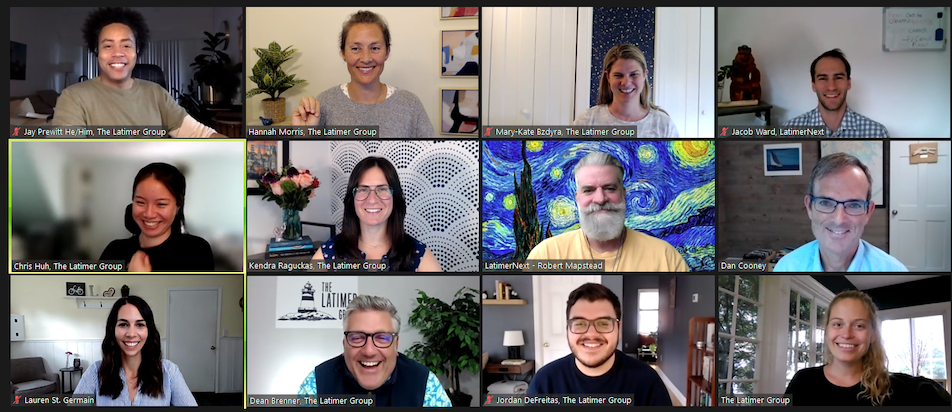
For some time, I’ve been looking for one “source” that curates modern takes on HR Tech, perspectives from the people who build it, and its impact on enterprise — something that’s tailor-made by professionals for decision-makers.
I never found it — so I decided to build it.
Every week, I’ll be sharing fresh insights on tech platforms, design, data, and the future of work — straight to your inbox.
This week, we’re joined by guest author Dean Brenner of The Latimer Group.
My Thoughts
Hello, all! I am Dean Brenner, CEO and Founder of The Latimer Group. As someone who has built a company and my career around communicating and connecting with others, I couldn’t be more excited to write to you all today.
Even after that introduction, you may still be wondering, where did this guy come from? Unlike recent contributors, I am not one of the incredibly talented folks at SEI. Patrick and I met through our shared love of sailing, as teammates on a racing team several years ago. That background, and more recently as fellow business consultants, has kept us in contact over the years.
Sailboat racing is actually going to be a common thread throughout today’s newsletter. Don’t worry if you don’t “speak sailing.” I won’t be talking about jibes or knots or whether organizations should be turning to port or starboard. However, after a lifetime of passion for the sport and 20 years working with the United States Olympic Sailing Program, I’ve learned a few things that will translate for you. The leadership, presence, and communication skills I developed throughout my sailing career are fundamental to how I manage my team and company. And I believe that those skills have had a positive impact on everyone within our company, and the clients we serve.
In the world of sailing, nothing is more important than the ability to confidently read and react to change. The best competitive sailors are the ones who can anticipate and navigate the ever-shifting balance between a well-developed strategy and adapting that strategy to environmental changes as they arise. Sound familiar?
In this newsletter, I’ll walk through the highs and lows our organization experienced throughout the pandemic: where we struggled, where we succeeded and why, and the relevant translation for you.

Winds of Change
The Latimer Group is a small executive coaching and training firm, and we specialize in transforming Fortune 500 organizations through executive communication skill-building. Since our founding in 2002, we have always offered our services in-person through onsite workshops to create educational but challenging environments. And prior to March of 2020, we were also a fully in-office company, like most organizations at the time.
Then, March 13th, 2020, happened. In one day, we were forced to reckon with the reality that both our primary service offering and the core of our organizational culture had been completely upended.
Of all the problems we were facing, three pain points stand out in hindsight:
- Redefining what we did and how we did it — simultaneously. Looking back, it’s clear now that our problem wasn’t that our programs didn’t translate to a virtual format; we just had never even had to consider it. We had near-zero revenue in Q2 2022, and social distancing guidance pushed us to cancel most existing client engagements. And while this morale blow was hitting the team, the lack of normalcy and togetherness disrupted creativity, and forced us to learn how to interact with each other in an entirely different way.
- Navigating the new rules of virtual working. A fully onsite team affords the luxury of knowing your coworkers are available from 9-5. If someone doesn’t respond to your email fast enough, all you need to do is poke your head into their office. Undoubtedly, the unanticipated transition to asynchronous work ruffled some feathers. And it wasn’t made any easier by sudden and absolute reliance on elements of our organization’s tech stack to manage projects, facilitate communication, and share visibility — all things we once fielded almost absentmindedly in a meeting that definitely could have been an email (oh how naive we were).
- Making sure employees internalized my request to prioritize themselves — and their families, their mental well-being, and their kids, who were suddenly home all day every day with barebones virtual learning programs that often required assistance for younger students. Fortunately, this seemed like the easiest of all the adjustments, thanks to a strict personal principle: intent is only as useful as impact. I have my hands in almost every aspect of running The Latimer Group. From confirming invoices are paid and writing content for our blog to watering the plants, small business owners understand how much boots-on-the-ground work leadership does. Not just because we want to keep operations running smoothly and profitably but because the decision to start your own business is born out of a desire to create something great. And that takes work — a lot of work.
Weathering the Storm
Big and small, the challenges we faced in the first few months of the pandemic challenged our team collectively and individually. But despite core elements of our company culture being rocked, a few crucial values within the team led the way.
How we managed:
- Absolute trust: In discussing ideas for this newsletter with Patrick, he insisted I include a phrase I used to describe my leadership style: I like to have really good people, and I like to stay out of their way. When we switched to remote, I chose to trust that everyone on the team wanted to make things work as badly as I did, and that they’d each find the best balance between work and personal well-being.
- Acknowledging (possibly even embracing) uncertainty: I knew one of the biggest challenges for The Latimer Group would be staying resilient in the face of uncertainty. Sailing is all about balancing what you prepared for vs. what you’re facing in the moment. In the “old normal,” stability, consistency, and long-term planning were pillars of our success. Therefore, I made it a priority to remind teams that long-term planning was no longer a fruitful option — that even our shortest-term strategies may need revisions, and that wasn’t a bad thing. In our world, “long term planning” used to mean 6-12 months. But in Q2 of 2020, long term planning quickly became 7-14 days.
- Looking towards blue skies: Over the next few months, our employees began to settle into the new normal, and with new habits came the return of creative space. We continued adapting our service offerings for virtual delivery and found our clients ready and waiting, budget in hand, to pick up right where we’d left off. The marketing team developed and deployed new digital acquisition strategies to complement our expanding global footprint, which would never have been possible without new virtual programs. And as the pandemic began receding, our employees embraced the benefits of remote work — so much so that we are still 95% hybrid. In fact, Q4 of 2020 was the busiest quarter we had experienced to date, something I would never have expected after everything we’d experienced.
Running a tight ship isn’t always about total control. In the modern world of work, over-management can frustrate employees and stifle innovation. If you want to set your company up for smooth sailing, I’ll leave you with three tips to make it happen:
- Create an environment that great people want to be a part of.
- Hire great people and stay out of their way.
- Be such a great captain that people don’t want to leave.

Editor’s Picks
- The importance of self-identifying as a leader.
- Finding your own executive voice.
- What is “labor hoarding?”


